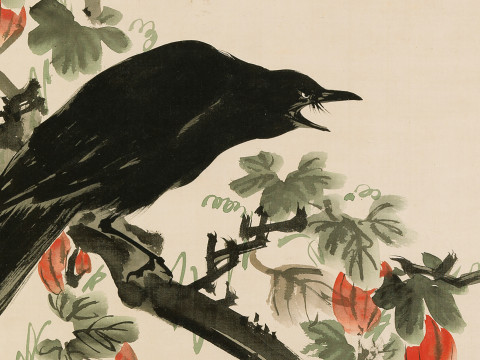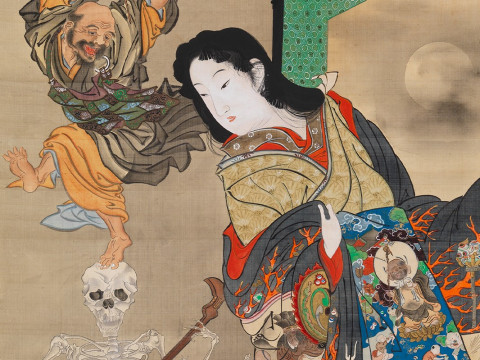
8 questions to ask yourself about Kawanabe Kyōsai
Published on 4 April 2022
Wondering what you need to know about Kawanabe Kyōsai before you visit the exhibition of his work at the RA? Here are some questions to ask yourself about the artist's life and work.
Who was Kawanabe Kyōsai?
He isn’t as well-known as Hokusai or Hiroshige perhaps, but in his time the artist was celebrated far and wide as a virtuoso.
Kyōsai’s art is full of bawdy humour, wild parties and animal characters (think acrobatic frogs, sassy cats, monkeys galore). But he also captured Japan at a turning point in the country’s history when – following two centuries of near isolation – the nation opened up to foreigners who brought cannons, treaties and a strange new piece of attire called a top hat.
These cultural shifts and periods of political instability and violence provided ample source material for his art which ranged from painting and woodblock prints, and which continue to inspire artists today, especially those working in manga and tattoo art.
What was Kyōsai's Japan like?
When Kyōsai died in 1889, the Japan he left behind was a very different place to the country he was born into in 1831.
From the 1600s Japan had been ruled by a political and military administration known as the ‘shogunate’, but by the 1830s this hierarchical system was starting to fall apart. In addition to this, in the 1850s Western powers, led by the USA, demanded diplomatic relations with Japan at gunpoint.
These tensions came to a head in 1868 when civil war toppled the administration Kyōsai had grown up under and ushered in the Meiji era. Under the modernising Meiji administration political conflicts continued and newly introduced systems and cultures were often at odds with traditional values, all while Western influence in the country became more pronounced.

Why are there so many frogs?
Kyōsai liked frogs. The first sketch he did (when he was a young child) was of a frog and the animal seems to have remained a favourite subject ever since, at least partly due to its comic potential.
He often used frogs to depict the lives of ordinary people. Look out for a large cast of frogs in paintings throughout our exhibition, working as street performers, postal workers and rickshaw drivers, or learning by rote from a lotus-leaf wallchart at a frog school.

What's the significance of the crows?
For Kyōsai crows symbolised his success as a painter. One of the paintings that made him famous in Japan was Crows on a Withered Branch which won him prizes and was sold to a collector for the hefty sum of 100 yen (enough money to buy 400 bottles of saké).
British architect Josiah Conder sent some of Kyōsai’s crow paintings back to England in the early 1880s, leading to commissions for similar paintings from around the world.
Are those people farting?
Yes.

Why?
They’re having a fart battle.
This subject is older than you might think, dating back to the twelfth century.
Fart battle paintings are a way of caricaturing how ridiculous the human urge to compete is. They’re also a fun comic subject for a witty artist like Kyōsai.
In his fart battle paintings he introduces new ideas to the tradition, such as ‘firing’ a farter by squeezing their belly with a length of cloth, or showing the sheer power of a fart by depicting heavy sacks of rice being blown away.
What’s a shogakai?
A shogakai was a commercially organised 'painting and calligraphy party' which celebrated spontaneous, free creativity. These events were as much about the drama of the painting process as the end results and were often irreverent and drink-fuelled with copious amounts of saké consumed.
Kyōsai was arrested after one particularly raucous shogakai and served a spell in prison for producing images that insulted the powers of the day.

Why is that skeleton wearing a top-hat?
During Kyōsai’s lifetime Japan underwent a process of Westernisation. Kyōsai is likely poking fun at this in Skeleton Shamisen Player in Top Hat with Dancing Monster.
The skeleton in newfangled Western clothing seems to suggest that even when people follow new fads and fashions and put on a different appearance, nothing has changed below the surface.
Kyōsai: The Israel Goldman Collection takes place in The Gabrielle Jungels-Winkler Galleries, Royal Academy of Arts, London, 19 March–19 June 2022.
Related articles

Frogs and Fart Battles: Kyōsai in 60 seconds
11 April 2022

Kawanabe Kyōsai: the demon with a brush
2 March 2022

Quiz: which artist are you?
1 March 2022
